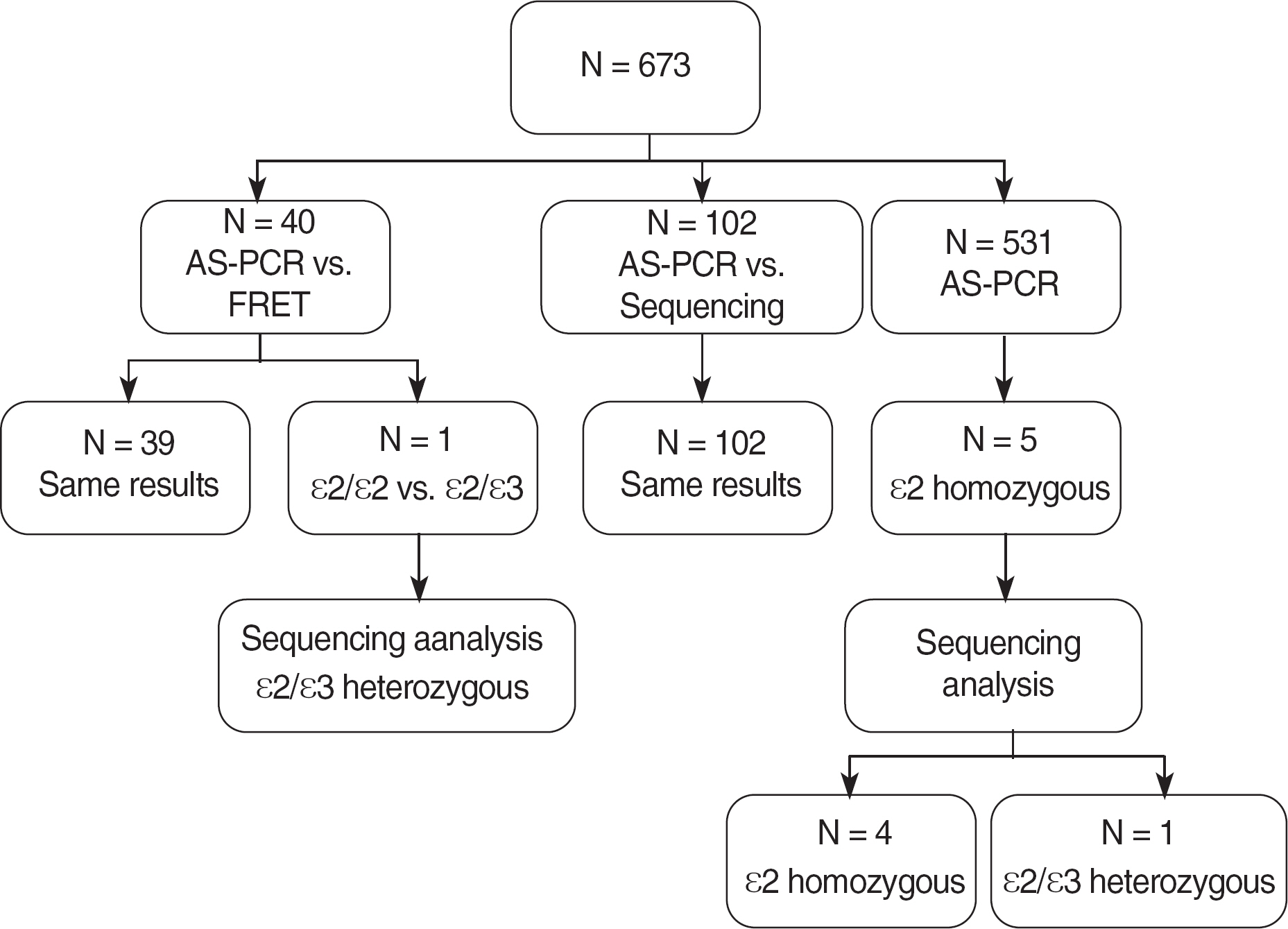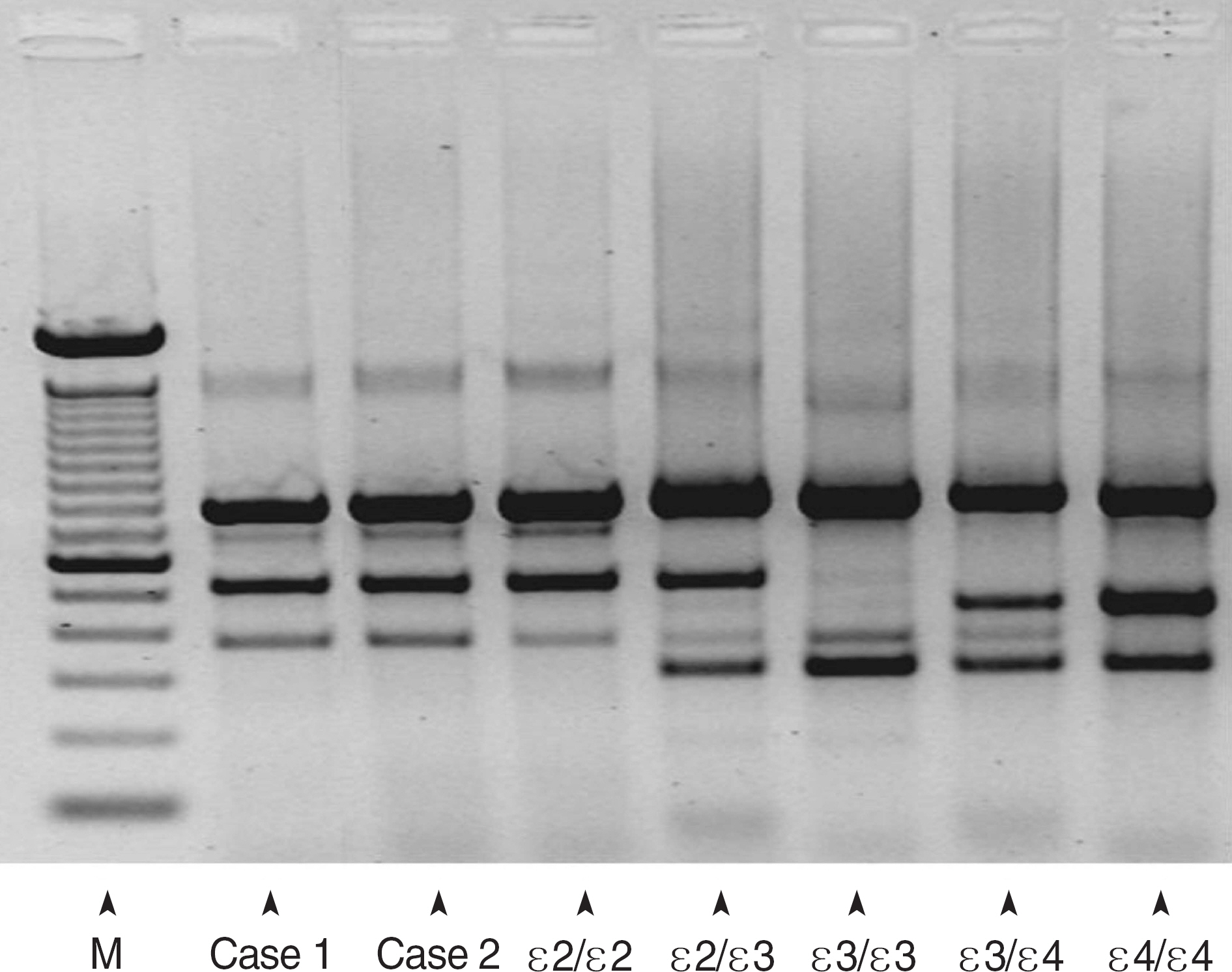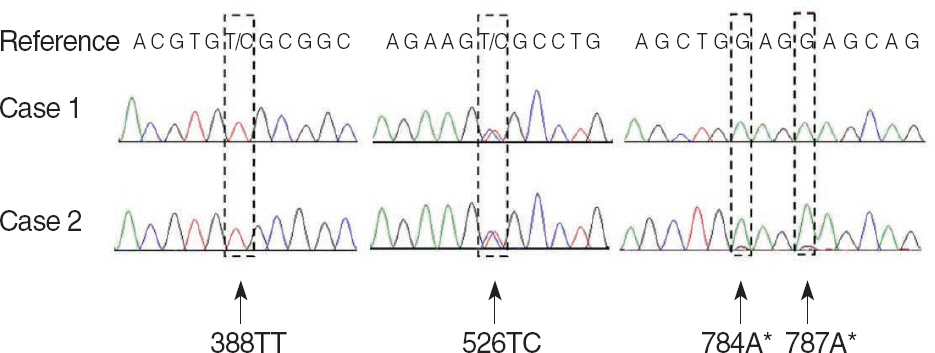Korean J Lab Med.
2010 Jun;30(3):325-328. 10.3343/kjlm.2010.30.3.325.
Discrepancy in Genotyping of Apolipoprotein E between Allele-Specific PCR and Fluorescence Resonance Energy Transfer or Sequencing
- Affiliations
-
- 1Department of Laboratory Medicine and Genetics, Samsung Medical Center, Sungkyunkwan University School of Medicine, Seoul, Korea. changski@skku.edu
- KMID: 1781635
- DOI: http://doi.org/10.3343/kjlm.2010.30.3.325
Abstract
- The human apolipoprotein E (APOE) gene contains several single-nucleotide polymorphisms (SNPs) that are distributed across the gene. The genotype of the APOE gene has important implications as a risk factor for various diseases. We observed 2 cases in which the results of allele-specific PCR (AS-PCR) of the APOE gene were not consistent with those of fluorescence resonance energy transfer (FRET) or sequencing analysis. In these cases, genotyping by AS-PCR showed that patients were epsilon2 homozygotes, while sequencing analysis and FRET showed that they were epsilon2/epsilon3 heterozygotes. Herein, we describe the causes of the errors in genotyping and describe the significance of these errors.
MeSH Terms
Figure
Cited by 2 articles
-
Apolipoprotein E4: A Risk Factor for Successful Cognitive Aging
Oh Dae Kwon
Dement Neurocogn Disord. 2016;15(3):61-67. doi: 10.12779/dnd.2016.15.3.61.Apolipoprotein E4: A Risk Factor for Successful Cognitive Aging
Oh Dae Kwon
Dement Neurocogn Disord. 2016;15(3):61-67. doi: 10.12779/dnd.2016.15.3.61.
Reference
-
1.Nickerson DA., Taylor SL., Fullerton SM., Weiss KM., Clark AG., Stengard JH, et al. Sequence diversity and large-scale typing of SNPs in the human apolipoprotein E gene. Genome Res. 2000. 10:1532–45.
Article2.Corder EH., Saunders AM., Strittmatter WJ., Schmechel DE., Gaskell PC., Small GW, et al. Gene dose of apolipoprotein E type 4 allele and the risk of Alzheimer's disease in late onset families. Science. 1993. 261:921–3.
Article3.Utermann G., Hees M., Steinmetz A. Polymorphism of apolipoprotein E and occurrence of dysbetalipoproteinaemia in man. Nature. 1977. 269:604–7.
Article4.Gomez-Isla T., West HL., Rebeck GW., Harr SD., Growdon JH., Locascio JJ, et al. Clinical and pathological correlates of apolipoprotein E epsilon 4 in Alzheimer's disease. Ann Neurol. 1996. 39:62–70.5.Roses AD. Apolipoprotein E alleles as risk factors in Alzheimer's disease. Annu Rev Med. 1996. 47:387–400.6.Strittmatter WJ., Saunders AM., Schmechel D., Pericak-Vance M., Enghild J., Salvesen GS, et al. Apolipoprotein E: high-avidity binding to beta-amyloid and increased frequency of type 4 allele in lateonset familial Alzheimer disease. Proc Natl Acad Sci U S A. 1993. 90:1977–81.
Article7.Kim DS., Lee HS., Choi SI., Suh SP. Modified and improved ARMS PCR method for apolipoprotein E genotyping. Korean J Clin Pathol. 2000. 20:150–6.8.Donohoe GG., Salomaki A., Lehtimaki T., Pulkki K., Kairisto V. Rapid identification of apolipoprotein E genotypes by multiplex amplification refractory mutation system PCR and capillary gel electrophoresis. Clin Chem. 1999. 45:143–6.
Article9.Ballerini S., Bellincampi L., Bernardini S., Casciani S., Motti C., Cortese C, et al. Apolipoprotein E genotyping: a comparative study between restriction endonuclease mapping and allelic discrimination with the LightCycler. Clin Chim Acta. 2002. 317:71–6.
Article10.Nauck M., Hoffmann MM., Wieland H., Marz W. Evaluation of the apo E genotyping kit on the LightCycler. Clin Chem. 2000. 46:722–4.
Article11.Tajima S., Yamamura T., Menju M., Yamamoto A. Analysis of apolipoprotein E7 (apolipoprotein E-Suita) gene from a patient with hyperlipoproteinemia. J Biochem. 1989. 105:249–53.12.Yamamura T., Dong LM., Yamamoto A. Characterization of apolipoprotein E7 (Glu(244) → Lys, Glu(245) → Lys), a mutant apolipoprotein E associated with hyperlipidemia and atherosclerosis. J Lipid Res. 1999. 40:253–9.13.Dong J., Balestra ME., Newhouse YM., Weisgraber KH. Human apolipoprotein E7:lysine mutations in the carboxy-terminal domain are directly responsible for preferential binding to very low density lipoproteins. J Lipid Res. 2000. 41:1783–9.
- Full Text Links
- Actions
-
Cited
- CITED
-
- Close
- Share
- Similar articles
-
- A Comparative Study of Apolipoprotein E Genotyping: INNO-LiPA ApoE Kit, Allelic Discrimination with LightCycler, and BioCore ApoE Kit
- CYP3A5 rs776746 Genotyping by SYBR GreenBased Real-Time Multiplex Polymerase Chain Reaction Combined with Melting Curve Analysis Using Tm-Shift Method
- Six Years' Experience Performing ABO Genotyping by PCR-direct Sequencing
- An Algorithm to Work-up ABO Subgroups Presenting as Weak B in a Real-world Laboratory: A Case with a Weak B Phenotype Harboring B101/O04-variant Alleles
- Apolipoprotein E Genotyping Using Polymerase Chain Reaction-Restriction Fragment Length Polymorphism with General-Purpose Agarose and Lithium Borate Buffer





